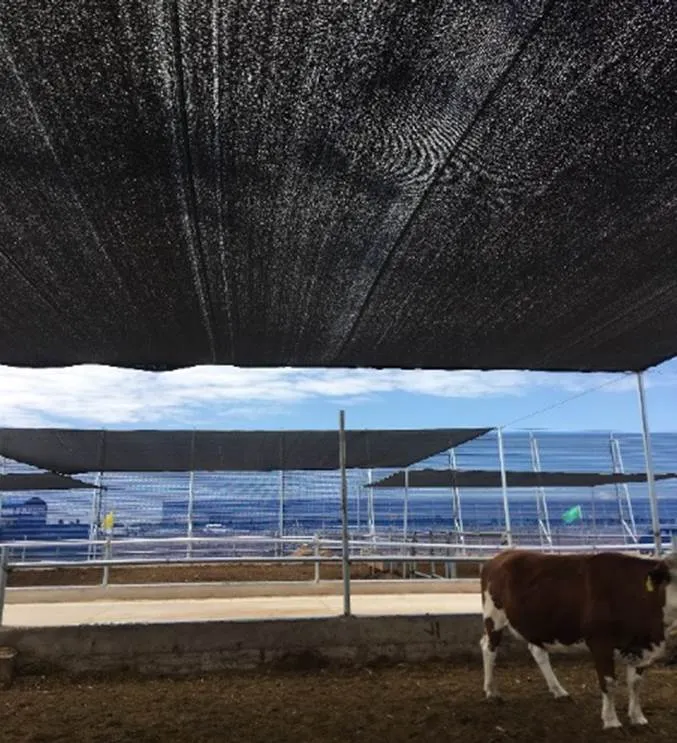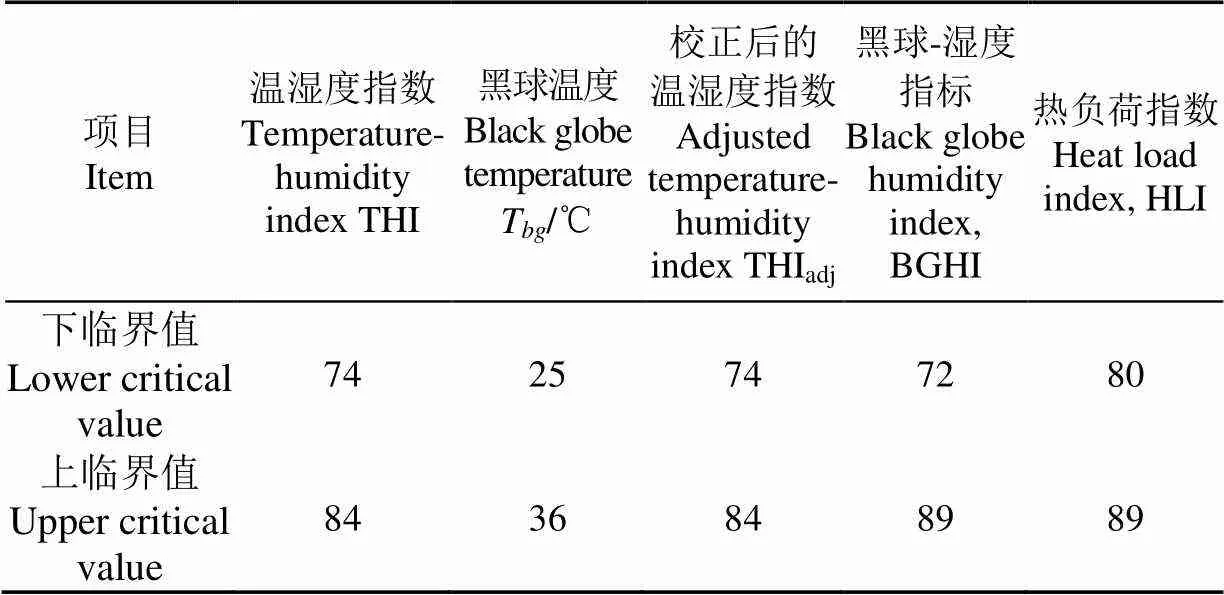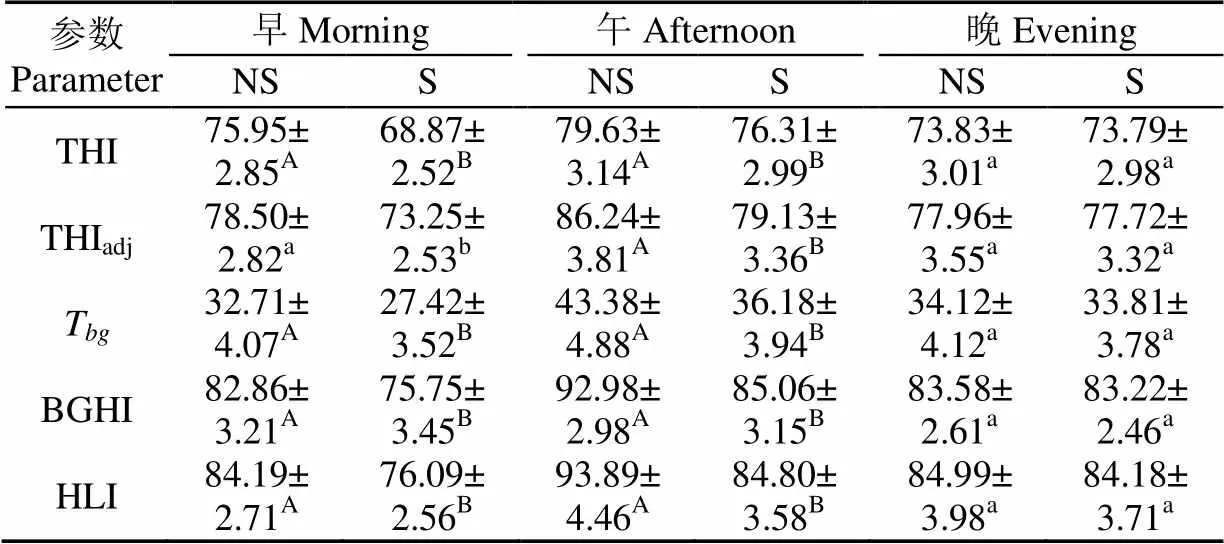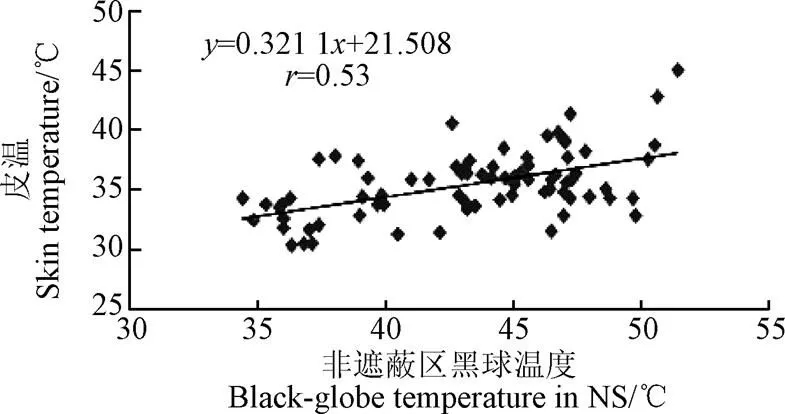遮阳网对西北地区夏季围栏牛场环境和肉牛生理特征的影响
2019-07-23陈昭辉熊浩哲张霞霞刘继军
陈昭辉,熊浩哲,张霞霞,刘继军,林 梁
遮阳网对西北地区夏季围栏牛场环境和肉牛生理特征的影响
陈昭辉1,2,熊浩哲1,2,张霞霞1,刘继军1,2※,林 梁3
(1. 中国农业大学动物营养学国家重点实验室,北京 100193; 2. 中国农业大学动物科技学院,北京 100193;3. 张掖市祁连牧歌有限公司,张掖 734000)
为了研究遮阳网在中国西北地区应用于围栏育肥牛场以缓解夏季肉牛热应激的效果,该试验对现场环境指标进行实测,同时对肉牛的皮肤温度、呼吸频率进行了记录,通过数据分析,对不同时段牛场的温热环境进行了评价。结果表明:遮阳网在各个时段都能改善肉牛生长环境,在午时可减少87%的太阳辐射,使温度降低3.95 ℃,黑球温度降低19.9%,从而将环境从严重热应激状态转变为中度热应激状态;中午肉牛的躺卧行为百分比从14.21%升高至59.9%(<0.01),而站立行为的百分比从64.5%降至29.7%(<0.01),且各个时段肉牛饮水行为占比较低;非遮蔽区的黑球温度与肉牛皮温和呼吸频率的相关性最高,相关系数分别为0.53和0.20。以上结果通过环境和肉牛生理特征的变化,反映了遮阳网主要通过减少太阳辐射来降低肉牛热应激水平,改善肉牛的生长环境,从而在维持其生产性能的同时提高了动物福利。该研究可为遮阳网在中国肉牛行业中的应用效果提供参考。
降温;温度;太阳辐射;遮阳网;热应激;环境;肉牛
0 引 言
经过将近30年的发展,中国肉牛产业已形成西北、中原、东北、西南4大产业带,肉牛存栏量、屠宰量和牛肉产量约占全国的90%左右[1]。其中西北地区幅员辽阔,农牧资源丰富,肉牛产业发展潜力大,然而由于太阳辐射造成的夏季高温往往给牛群造成严重的热应激。研究表明,在炎热的夏季,太阳辐射会使环境温度升高,畜体吸收热量,肉牛代谢加快,饲料报酬低。因此高温对不采取任何遮荫措施的牛的健康、福利和生产性能等方面都有巨大的负面影响[2]。轻者会降低采食量、饲料利用率和生长速率,重者则可能导致机体代谢衰竭最终死亡,这使得热应激给肉牛生产带来巨大的经济损失[3]。
降低夏季太阳辐射的措施通常有遮阳网遮阳、绿化遮阳、利用喷淋技术等。研究表明,树木提供的遮荫可以在改善奶牛运动场极端温度的同时减缓风速,既能保证产奶量又有利于动物福利[4]。Tucker等[5]发现在炎热的气候条件下,奶牛在遮荫区活动的倾向十分明显。但由于绿化遮阳投资往往较大,适用性不广。喷淋技术在降低温度的同时也增大了动物活动区的空气湿度与环境温湿度指数,其应用效果不尽人意[6]。遮阳是近年来备受关注的一种降温策略,不同类型的材料可以达到不同的遮阳效果。在选择遮阳网时需要考虑以下要素:遮阳材料的物理特性、动物对材料的反应、材料的耐用性和其生产成本[7]。为应对夏季奶牛热应激,Eigenberg等[8]研究表明黑色塑料材质遮阳网的遮阳效果可达60%,可作为一种经济实用的降温措施。目前,遮阳网已在中国温室种植业中广泛应用于冬季保温和夏季降温,并得到了较好的节能效果和经济效益,但有关其在畜牧业应用效果的研究较少,除在猪舍中发现使用黑色遮阳网的猪舍平均温度为29.3 ℃,平均湿度为70%外[9],在其他畜禽上鲜有应用。尤其是在遮阳网对围栏育肥场小气候影响方面的研究还未见报道。
牛的耐热性与品种(系)、生产性能有密切关系[10-11]。西杂牛是为改善中国地方黄牛生产性能而与西门塔尔牛杂交的改良种,在中国农区和牧区肉牛养殖中有着举足轻重的地位。然而目前关于反刍动物热应激的研究主要集中于奶牛,国内肉牛热应激的研究几乎处于空白状态[12-13]。因此,探究缓解西杂牛热应激的方法在肉牛养殖领域具有重要意义。本试验从环境指标和肉牛行为生理指标两方面衡量遮阳网在中国西北地区围栏育肥牛场的遮阳降温效果,以期确定可靠的环境指标以预测当前牛群生理特征的变化,为缓解西北地区夏季肉牛的热应激提供参考。
1 材料与方法
1.1 围栏育肥牛场
本试验在甘肃省张掖市(38.55°N,100.26°E)的祁连牧歌围栏育肥牛场进行,试验时间为2018年6月至同年7月。张掖位于中国甘肃省西北部,河西走廊中段,属于温带大陆性干旱气候。夏季炎热而短暂,气温日差较大,7月平均温度为11~24 ℃,日间最高气温达41.5 ℃,风向以西北风和东风为主[14]。
围栏育肥牛场长198 m、宽100 m,牛场内共设置4排牛栏,每排11列,牛栏长18 m、宽18 m。第二排牛栏沿对角线在距离地面3 m处安装2块9 m×9 m的黑色塑料材质遮阳网(见图1),其针数为4针,透光率在40%左右,可为每头牛提供5.4 m2的遮阳面积。每个栏位饲养12头西门塔尔杂交牛,其被毛呈红白色。每牛栏内配有一个饮水槽,供肉牛自由饮水;饲喂方式为人工饲喂,时间为8:00与17:00;全天不清粪;试验期间的饲料配方为:麦草1 kg,苜蓿0.5 kg,青贮玉米9 kg,全价料7 kg,玉米粉1.5 kg,小苏打60 g。肉牛自由活动,无法控制其所在区域。

图1 围栏育肥牛场遮阳网布置图
1.2 检测方法
试验检测指标包括温度、相对湿度、风速、太阳辐射强度、肉牛体表温度、呼吸频率、肉牛行为。各环境指标每天测定3次,时间为7:00、14:00、19:00,且分别记录为早、午、晚。在第二排牛栏中选择3个牛栏进行环境指标的测定,具体布点图见图2,同时将遮蔽区记为S(shade area),非遮蔽区记为NS(no shade area)。根据头牛体尺,本试验的测定高度选取0.7、1.4 m作为肉牛躺卧、站立高度。对于温度、湿度、风速、热辐射的测定:分别使用手持温湿度测定仪(HE710-EX,北京思普特科技有限公司)、风速计(MODEL600,加野麦克斯Kanomax)、手持热辐射检测仪(TD-JTR09,北京同德创业科技有限公司)对20个环境指标测点进行测定,采样间隔10 min;对于肉牛体表温度的测定:每个测定栏位选择2头体质量、年龄及生理状况相似的肉牛,使用激光红外测温仪(HT-8962,上海宏诚科技)测定肉牛腹部皮肤表面温度;对于呼吸频率的测定:观察腹部的起伏情况,记录肉牛1 min的呼吸次数;对于肉牛行为的记录:分躺卧、站立、饮水、采食4种行为,其中把肉牛的走动行为也归类为站立行为,记录各行为牛的数量占牛总数的百分比。

注:●代表环境指标测定点;阴影区表示遮阳区域
Note: ● represents for environmental measuring points; Shaded area represents the shaded area of sunshade net
图2 环境指标测定点平面布置图
Fig.2 Arrangement plan of environmental measuring points of layout plan
1.3 热应激评价指标
选取常用的环境评价指标评价肉牛的热应激程度,温湿度指数(temperature-humidity index,THI)与黑球温度(black globe temperature,T)。虽然T和THI都考虑了2个环境因素,但并不全面,其中T没有考虑空气的流动与环境湿度,THI没有考虑空气流动与热辐射[15]。因此采用3个综合指标,包括校正后的THI(adjusted temperature-humidity index,THIadj)、热负荷指数(heat load index,HLI)和黑球-湿度指标(black globe humidity index,BGHI)以考虑太阳辐射、风速、湿度的影响。上述环境指标的计算公式分别如式(1)~式(6)所示[8,16-17]。
THI=(0.8T)+(/100)×(T−14.4)+46.4 (1)
T=1.33T−2.65T0.5+3.21×lg10(+1)+3.5 (2)
THIadj=4.51+THI−1.992+0.006 82.5(3)
BGHI=(0.8T)+(/100)×(T−14.4)+46.4(4)
若T>25 ℃,
HLI=8.62+0.38+1.55T−0.5+e(2.4-WS)(5)
若T<25℃,
HLI=10.66+0.28×+1.3×T−(6)
式中T为环境温度,℃;为相对湿度,%;为太阳辐射热,W/m2;为风速,m/s;e为自然对数。
根据之前的试验结果[16-20],评价肉牛热应激程度的各指标阈值如表1所示。其中HLI的初始临界值是以未遮阳、黑色普通牛的喘息评分建立的,其上、下临界值分别为86和77,可根据牛的品种及实际饲养情况进行校正[18]。本次试验对象为生理健康、舍饲130 d以上、被毛红白相间的西门塔尔杂交牛,遮阳面积为5.4 m2/头,饮用15~20 ℃的地下水,全天不清粪。因此,其校正后的上、下临界值分别为89和80[17]。

表1 热应激阈值
1.4 试验仪器
试验仪器如表2所示。

表2 试验仪器
1.5 数据分析
试验数据采用Excel与SPSS20.0软件进行分析,结果以“平均值±标准差”的形式表达,<0.05为差异显著,<0.01为差异极显著,>0.05为差异不显著。
2 结果与分析
2.1 肉牛热应激程度
2.1.1 环境实测结果
试验期间围栏育肥牛场遮蔽区与非遮蔽区在各个时段的温度、湿度、风速以及太阳辐射热的实测结果如表3所示。试验数据表明:由于该地昼夜温差大,再加上太阳辐射的影响,造成不同时段肉牛场的环境状况差异较大,具体表现为早晚温度较低,湿度较高;午间温度最高,湿度最低;早、午时段,遮阳网能显著降低牛场的温度,提高湿度(<0.01),而对风速无影响;在傍晚,遮蔽区与非遮蔽区的环境差异不显著(>0.05),说明此时遮阳网不改变牛场环境。对于太阳辐射热而言,在中午遮阳网的效果最为明显,可减少87%的太阳辐射,但在傍晚,由于太阳直射角度发生变化,遮阳网仅能减少约20%的太阳辐射,遮蔽区与非遮蔽区的辐射热无显著差异(>0.05)。通过以上结果可以推断,遮阳网主要通过减少太阳辐射来降低环境温度、提高湿度,从而改善肉牛的生长环境,降低其热应激水平。
研究表明,肉牛适宜的饲养温度为10~15 ℃,最适育肥温度为15~20 ℃。在夏季日平均温度超过21 ℃时,肉牛的呼吸频率上升,当平均温度超过25 ℃时,肉牛的采食量与日增质量都有明显的降低,育肥的温度应低于30 ℃[20-21]。因此,常以25 ℃作为夏季肉牛较好生产环境温度的界限,30 ℃作为肉牛的高温生产环境界限;对于湿度而言,NY/T388-1999规定牛舍环境湿度上限为80%[22],肉牛适宜的相对湿度为40%~70%;对于风速而言,一般认为牛舍夏季的通风速度以0.8~1.0 m/s为宜[23]。因此,根据表3中结果可知:在早晨,遮阳网能使环境温度保持在25 ℃以下,保证了肉牛的福利及其生产性能;午时遮阳网的效果达到最佳,与非遮蔽区相比,遮蔽区温度降低了3.95 ℃,湿度增加4.66个百分点,太阳辐射减少了87%,但仍然不利于肉牛的生长;傍晚遮阳网虽有改变环境的趋势,但效果并不显著;各时段风速基本满足夏季肉牛通风需求。

表3 环境实测结果
注:同一时段内,同行数据不同大写字母表示数值存在极显著差异,<0.01,相同小写字母表示无显著差异,>0.05,下同。遮蔽区记为S,非遮蔽区记为NS,下同。
Note: During the same period of time, different capital letters indicate that there is a extremely significant difference in the values within the same line of data with,0.01, and the same lowercase letter means that there is no significant difference,0.05, Same as below. The shaded area is denoted as S and the non-shaded area as NS, Same below.
2.1.2 环境综合评价
试验期间围栏育肥牛场各环境综合指标值如表4所示。由表4可知,在各个时段,遮蔽区的各项环境评价指标均低于非遮蔽区;午时非遮蔽区的环境会给牛群造成巨大的热应激,其中THIadj、BGHI与HLI的平均值分别为86.24、92.98、93.89,均超过了各自的上临界值,因此可判读午时肉牛处于严重热应激状态;遮阳网能降低热应激程度,其中以午时HLI值的降低幅度最为明显。与非遮蔽区相比,遮蔽区HLI值降低了9.09,环境由严重热应激状态转变为中度热应激状态;在傍晚,由于太阳直射角度的改变,各项环境综合指标均在其下临界范围内,同时遮蔽区与非遮蔽区的各项环境指标之间无差异(>0.05)。说明此时环境适宜,且遮阳网对环境的影响程度小,不能改善环境的热应激程度。

表4 环境综合指标值
2.1.3 生理特征测定结果
试验期间牛场遮蔽区与非遮蔽区未隔开,肉牛可自由活动。各时段对肉牛皮温、呼吸频率的记录如表5所示。经测量,7:00、14:00、19:00肉牛各时段的皮温分别为(30.45±3.38)、(35.24±2.50)、(31.76±2.56)℃,且三者之间存在显著差异(<0.05);呼吸频率分别为(44.63±10.04)、(48.74±11.32)、(34.93±8.63)次/min,且三者之间存在显著差异(<0.05)。

表5 皮温及呼吸频率的测定结果
研究表明,在适宜的环境温度下,牛的呼吸频率为20~40次/min,皮温为38.5 ℃左右。热应激状态下肉牛通过增加呼吸频率来增加蒸发散热[8],当产热量超过散热量时,动物的体温就会升高[24]。试验结果显示:各时段肉牛的皮温均在38.5 ℃以下,但早晨肉牛的呼吸频率为44.63次/min,午时为48.74次/min。由此可以判断,牛群在早、午时段均处于热应激状态,且午时的热应激程度更高。傍晚的呼吸频率在适宜范围内,说明此时牛场的环境较为舒适,动物无热应激反应。
2.2 热环境对肉牛的影响
2.2.1 热环境对肉牛生理特征的影响
在热应激条件下,机体交感神经兴奋导致体温升高,散热困难。机体通过加快肺通气量加快呼吸散热,此时表现为呼吸频率升高,机体易发生呼吸性碱中毒。严重时,会导致肺部、出血、呼吸功能衰竭等症状。故呼吸频率与环境温热条件存在极大的相关性。结合表4与表5可知,肉牛皮温与呼吸频率的变化特征与热应激程度变化相似:早晚皮温与呼吸频率较低,中午最高。现将各环境综合指标按照遮蔽区与非遮蔽区分类,与肉牛呼吸频率和皮温的线性相关关系如表6所示。

表6 环境综合指标与肉牛生理特征之间的相关系数
注:*表中该环境综合指标和生理特征之间显著相关,<0.05,ns表示该环境综合指标和生理特征之间不显著相关,>0.05。
Note: * indicates there is a significant correlation between the environmental comprehensive parameters and physiological characteristics,< 0.05; ns means that there is no significant correlation between the environmental comprehensive parameters and physiological characteristics,> 0.05.
由表6可知,对于肉牛皮温而言,相关度最高的环境综合指标为非遮蔽区的黑球温度,相关系数为0.53,二者线性关系见图3。对于呼吸频率而言,各指标与呼吸频率的相关系数均偏低,相关关系不明显,其中相关系数最高的指标同样为非遮蔽区的黑球温度,二者相关系数为0.20,其次为遮蔽区的HLI,相关系数为0.17。

图3 皮温与非遮蔽区黑球温度线性关系
2.2.2 热应激对肉牛行为的影响
在试验期间观察到,随着热应激水平的增加,牛群更加倾向于在遮蔽区活动,且在中午躺卧行为多发生在遮蔽区。对于牛群站立、躺卧、采食、饮水行为的百分比在各个时段的分布如表7所示。结果表明在不同时段,肉牛的主要行为表现出一定的差异:从早晨到中午,肉牛的躺卧比例从14.21%升高至59.9%(<0.01),而站立的百分比从64.5%降低到29.7%(<0.01),说明遮蔽区牛群的热应激水平较低,肉牛无需维持站立姿势增加机体散热量;傍晚肉牛的行为与早晨相似,超过一半的肉牛表现为站立,采食与躺卧的百分比较为接近;各时段肉牛饮水的倾向不明显,均低于3%。根据上述结果,认为整体而言,肉牛的热应激程度不高。此外,牛场另饲有黑色被毛的安格斯牛,与被毛红白相间的西门塔尔牛相比,其趋向遮蔽区的行为更明显,躺卧的百分比也更高,如图4所示。

表7 不同时段牛群行为

图4 安格斯牛更倾向于在遮蔽区停留
3 讨 论
遮阳网可通过减少热辐射从而达到明显的降温效果。Schütz等[25]研究发现,在试验期间,太阳辐射减少50%或99%的遮蔽区的环境温度始终保持在25 ℃以下,且与同一时间的非遮蔽区相比,分别降低了日均温度2 ℃和3.8 ℃。Eigenberg等[26]研究发现,黑色塑料材质的遮阳网平均可减少60%的太阳辐射,同时可减少22%处于严重热应激状态的牛的数量。Brown-Brandl等[7]研究了不同遮蔽程度的遮阳网对环境的影响,结果表明与不采取任何遮蔽措施相比,任意程度的遮蔽都能降低黑球温度和太阳辐射,并且中午的遮蔽效果最明显:最多可使太阳辐射降低86.8%,黑球温度降低11.9%。本试验实测结果表明,遮阳网在午时最多可减少87%的太阳辐射,使温度降低3.95 ℃,黑球温度降低19.9%,同时将环境从严重热应激状态转变为中度热应激状态,其遮阳降温结果与上述试验结果相似。此外有研究表明,在炎热气候下,采取遮蔽措施会延长牛的采食时间和增加干物质摄入量,从而提高日增质量[27-28]。因此,可以认为试验期间采取的遮蔽措施对肉牛生产性能有积极影响。
通过肉牛行为,认为遮阳网可以改善夏季温热环境,降低热应激程度,提高动物福利。试验期间,观察到肉牛在中午使用遮阳网的频率高于早、晚时段。Tucker等[5]在研究夏季奶牛行为与热应激的试验中发现,在太阳辐射值较高的日子里,为应对增加的热负荷,奶牛在遮蔽区停留的时间会延长,当环境温度超过25 ℃时,牛群使用遮阳网的次数会增加;且在一天内,在太阳辐射值最高的时候,遮阳网的使用率达到峰值,这与本试验观察到的现象相吻合。研究表明,动物采取站立的姿势可以最大限度地增加暴露在环境中的表面积,以增加身体周围的空气流动[24]。Zahner等[29-30]的研究发现,在炎热的夏季,牛群会通过减少躺卧和采食行为来对热负荷做出反应。本试验发现在达到严重热应激条件的中午,肉牛更倾向于在遮蔽区停留,且躺卧行为的百分比较其他行为更高,可以认为由于遮阳网下的小气候环境较为舒适,所以牛群不必采取站立姿势来应对热负荷。Schütz等[31]也同样发现遮蔽区牛群的躺卧比例高于非遮蔽区。现有研究表明,深色被毛的牛比浅色被毛的牛对热应激更加敏感[32]。被毛白色的比利时蓝牛比黑色的安格斯牛的HLI上限高出3个单位,红色安格斯牛比黑色安格斯牛的HLI上限高1个单位[18]。根据上述结论可以解释试验期间观察到的黑色安格斯牛更偏好于使用遮阳网的现象。
各环境综合指标对肉牛生理特征的影响表明在本试验中,太阳辐射是影响肉牛生理特征的主要因素。研究表明,由于肉牛品种、被毛颜色、生长环境以及测量方法等的不同,各环境综合指标与生理特征之间的相关程度也不尽相同。牛的皮肤温度与其品种和被毛颜色相关,浅色被毛牛的皮温往往偏低,与体温之间相差约3.3 ℃[33]。同时Kendall等[34]发现牛群的体温、呼吸频率与气温、THI和HLI之间呈正相关关系。李璟辉等[15]研究了4个环境综合指标:BGHI、THVI、THI和HLI与西门塔尔肉牛呼吸频率之间的相关性,结果表明HLI与呼吸频率的相关性最大,相关系数为0.603 81。而在研究综合环境指数(comprehensive climate index, CCI)、HLI、BGHI、奶牛热应激指数(index of thermal stress for cows, ITSC) 4指标与奶牛生理特征的相关性时,发现CCI与荷斯坦奶牛的呼吸频率相关性最大,相关系数为0.365[35]。此外,Atkins[36]等利用探测器监测肉牛每日连续变化的生理特征与环境参数时发现,牛的呼吸频率、体温与THI的变化趋势高度一致。而在本试验中,非遮蔽区的黑球温度与皮温的相关性较高,二者的相关系数为0.53;各指标与呼吸频率的相关性较低,最大相关系数仅为0.20,其原因可能是观测的牛的数量较少,导致观测值的标准差较大,造成相关系数偏小。黑球温度主要受太阳辐射的影响,根据其与牛群生理特征的相关性可以推断,太阳辐射对肉牛的生理特征的影响占据主导地位,而遮阳网能通过降低太阳辐射。达到改善肉牛的生长环境,缓解热应激的目的。
4 结 论
本研究对设有黑色塑料材质,针数为4针,透光率约为40%的遮阳网围栏育肥牛场进行了现场环境指标实测,并通过数据分析,最终得出以下结论:
1)现场环境实测结果表明,遮阳网在各个时段都能改善肉牛的生长环境,且午时的效果最为明显:可减少87%的太阳辐射,使温度降低3.95 ℃,黑球温度降低19.9%,将环境从严重热应激状态转变为中度热应激。
2)肉牛行为的统计结果表明,随着热应激程度的升高,肉牛更倾向于在遮蔽区躺卧,且躺卧比例由14.21%升高至59.9%,站立比例由64.5%降低至29.7%。说明遮阳网下的小气候环境较舒适,能为肉牛提供适宜的饲养环境,提高动物福利。
3)分析各环境综合指标与肉牛生理特性的相关性,结果表明,非遮蔽区的黑球温度与肉牛皮温和呼吸频率的相关性最高,相关系数分别为0.53与0.20,进一步说明了遮阳网能通过降低太阳辐射来达到缓解肉牛热应激水平的目的。
综上,本试验通过环境指标的对比和对牛群生理特性的分析,阐明了遮阳网在中国西北地区围栏育肥牛场中的遮阳降温效果,可为缓解该形式肉牛场的夏季热应激提供参考。
[1] 刘玉凤,杨春,王明利. 中国肉牛产业发展现状及前景展望[J]. 农业展望,2014(4):36-42.
[2] Armstrong D V. Heat stress interaction with shade and cooling[J]. Journal of Dairy Science, 1994, 77(7): 2044-2050.
[3] 覃智斌,左福元. 肉牛热应激研究进展[J]. 现代畜牧兽医,2007(9):52-54.
[4] Hahn G. L. Dynamic responses of cattle to thermal heat loads[J]. Animal Science, 1999(77): 10-20.
[5] Tucker C B, Rogers A R, Schtz K E. Effect of solar radiation on dairy cattle behaviour, use of shade and body temperature in a pasture-based system[J]. Applied Animal Behaviour Science, 2008, 109(2/3/4): 141-154.
[6] 董晓林,张性雄. 奶牛舍遮阳技术的应用及其要求[J]. 福建农机,2007(3):45-46.
[7] Brown-Brandl T M, Chitko-McKown C G, Eigenberg R A, et al. Physiological responses of feedlot heifers provided access to different levels of shade[J]. Animal, 2017, 11(8): 1344-1353.
[8] Eigenberg R A, Brown-Brandl T M, Nienaber J A, et al. Dynamic Response Indicators of Heat Stress in Shaded and Non-shaded Feedlot Cattle, Part 2: Predictive Relationships[J]. Biosystems Engineering, 2005, 91(1): 111-118.
[9] 邵燕华. 中国南方地区夏季猪舍降温效果的实验研究[D]. 杭州:浙江大学,2002.
Shao Yanhua. Studies on Cooling Effect of Pig House in Summer in Southern China[D]. Hangzhou: Zhejiang University, 2002. (in Chinese with English abstract)
[10] Silanikove Nissim. Effects of heat stress on the welfare of extensively managed domestic ruminants[J]. Livestock Production Science, 2000, 67(1): 1-18.
[11] Collier R J, Collier J L, Rhoads R P, et al. Invited Review: Genes involved in the bovine heat stress response[J]. Journal of Dairy Science, 2008, 91(2): 445-454.
[12] 蒲启建,王之盛,彭全辉,等. 热应激对不同品种(系)青年肉牛生产性能、营养物质表观消化率及血液生化指标的影响[J]. 动物营养学报,2017(9):3120-3131.
Pu Qijian, Wang Zhisheng, Peng Quanhui, et al. Effects of heat stress on performance, nutrient apparent digestibility and blood biochemical indices of different breeds of young beef cattle[J]. Chinese Journal of Animal Nutrition, 2017(9): 3120-3131. (in Chinese with English abstract)
[13] 鲁煜建,王朝元,赵浩翔,等. 东北地区奶牛夏季热应激对其行为和产奶量的影响[J]. 农业工程学报,2018,34(16):225-231.
Lu Yujian, Wang Chaoyuan, Zhao Haoxiang, et al. Effect of heat stress of dairy cow on its behavior and milk yield in Northeastern China[J]. Transactions of the Chinese Society of Agricultural Engineering (Transactions of the CSAE), 2018, 34(16): 225-231. (in Chinese with English abstract)
[14] 张良,李耀辉,王胜,等. 张掖国家气候观象台常规气象资料检验分析[J]. 干旱气象,2010(1):49-53.
Zhang Liang, Li Yaohui, Wang Sheng, et al. Examination and analysis of meteorological data from Zhangye national climate observatory[J]. Journal of Arid Meteorology, 2010, 28(1): 49-53. (in Chinese with English abstract)
[15] 李璟辉,程琼仪,陈昭晖. 利用呼吸频率比较不同温热指数在牛舍的应用[J]. 家畜生态学报,2014(7):32-36.
Li Jinghui, Cheng Qiongyi, Chen Zhaohui. Comparing different thermal indices with respiration rate application and its in beef cattle barn[J]. ACTA Ecological Animals domastic, 2014(7): 32-36. (in Chinese with English abstract)
[16] Mader T L, Davis M S, Brown-Brandl T. Environmental factors influencing heat stress in feedlot cattle[J]. Journal of Animal Science, 2006, 84(3): 712-719.
[17] Wang Xiaoshuai, Bjerg Bjarne Schmidt, Choi Christopher Y, et al. A review and quantitative assessment of cattle-related thermal indices[J]. Journal of Thermal Biology, 2018, 77: 24-37.
[18] Gaughan J B, Mader T L, Holt S M, et al. A new heat load index for feedlot cattle[J]. Journal of Animal Science, 2008, 86(1): 226.
[19] Van Laer E, Moons C P H, Ampe B, et al. Effect of summer conditions and shade on behavioural indicators of thermal discomfort in Holstein dairy and Belgian Blue beef cattle on pasture[J]. Animal, 2015, 9(9): 1536-1546.
[20] 娄玉杰,周海柱. 肉牛场环境质量及其评价[J]. 现代畜牧兽医,2010(2):26-27.
[21] Hahn G L, Chen Y R, Nienaber J A, et al. Characterizing animal stress through fractal analysis of thermoregulatory responses[J]. Journal of Thermal Biology, 1992, 17(2): 115-120.
[22] 中华人民共和国农业部.NY/T388-1999:畜禽场环境质量标准[S]. 北京:中国标准出版社,1999
[23] 刘继军,贾永全. 畜牧场规划设计[M]. 北京:中国农业大学出版社,2008.
[24] St-Pierre N R, Cobanov B, Schnitkey G. Economic losses from heat stress by US livestock industries 1[J]. Journal of Dairy Science, 2003, 86(5): E52-E77.
[25] Schütz K E, Cox N R, Tucker C B. A field study of the behavioral and physiological effects of varying amounts of shade for lactating cows at pasture[J]. Journal of Dairy Science, 2014, 97(6): 3599-3605.
[26] Eigenberg R A, Brown-Brandl T M, Nienaber J A. Shade material evaluation using a cattle response model and meteorological instrumentation[J]. International Journal of Biometeorology, 2010, 54(5): 509-515.
[27] Gaughan J B, Bonner S, Loxton I, et al. Effect of shade on body temperature and performance of feedlot steers[J]. Journal of Animal Science, 2010, 88(12): 4056-4067.
[28] Mitl Hner F M, Morrow J L, Dailey J W, et al. Shade and water misting effects on behavior, physiology, performance, and carcass traits of heat-stressed feedlot cattle[J]. Journal of Animal Science, 2001, 79(9): 2327.
[29] Zahner M, Schrader L, Hauser R, et al. The influence of climatic conditions on physiological and behavioural parameters in dairy cows kept in open stables[J]. Animal Science, 2004, 78: 139-147.
[30] Overton M W, Sischo W M, Temple G D, et al. Using time-lapse video photography to assess dairy cattle lying behavior in a free-stall barn[J]. Journal of Dairy Science, 2002, 85(9): 2407-2413.
[31] Schütz Karin E, Rogers Andrea R, Cox Neil R, et al. Dairy cows prefer shade that offers greater protection against solar radiation in summer: Shade use, behaviour, and body temperature[J]. Applied Animal Behaviour Science, 2009, 116(1): 28-34.
[32] Nienaber J A, Eigenberg R A, Mader T L. Comparison of heat tolerance of feedlot heifers of different breeds[J]. Livestock Science, 2006, 105(1): 19-26.
[33] Allen J D, Hall L W, Collier R J, et al. Effect of core body temperature, time of day, and climate conditions on behavioral patterns of lactating dairy cows experiencing mild to moderate heat stress[J]. Journal of Dairy Science, 2015, 98(1): 118-127.
[34] Kendall P E, Verkerk G A, Webster J R, et al. Sprinklers and shade cool cows and reduce insect-avoidance behavior in pasture-based dairy systems[J]. Journal of Dairy Science, 2007, 90(8): 3671-3680.
[35] Roberto Gomes D S, Alex Sandro C M, Macedo Costa L L. Index of thermal stress for cows (ITSC) under high solar radiation in tropical environments[J]. International Journal of Biometeorology, 2015, 59(5): 551-559.
[36] Atkins I K, Cook N B, Mondaca Mario R, et al. Continuous respiration rate measurement of heat-stressed dairy cows and relation to environment, body temperature, and lying time[J]. Transactions of the ASABE, 2018, 61(5): 1475-1485.
Effects of sunshade net on environment of fenced feed lot and physiological characteristics of beef cattle in northwest China in summer
Chen Zhaohui1,2, Xiong Haozhe1,2, Zhang Xiaxia1, Liu Jijun1,2※, Lin Liang3
(1.100193,;2.100193,; 3. Gansu734000,)
In order to study the effects of sunshade net applied in fenced feed lot in northwest China to alleviate heat stress of beef cattle in summer, this paper was conducted to measure environmental parameters, and recorded the physiological characteristics of beef cattle to evaluate the environment of fenced feed lot in different periods. This test was in Zhangye city, Gansu province (38.55 °N, 100.26 °E). The experiment was conducted from June 2018 to July of the same year. The fence feed lot was 198 m long and 100 m wide. There were 4 rows of cattle pens in the feed lot, each row had 11 columns. The length of each pen was 18 m and the width of 18 m. 2 black plastic shading nets were installed along the diagonal of the second row of cattle hurdles, with a light transmittance of about 40%, providing a shading area of 5.4 m2for each cattle. Each stall was provided with a drinking tank for beef cattle to drink freely, and the feeding method was manual feeding at 8:00 and 17:00. 12 Simmental crossbred beef cattle with red and white coats were kept in each stall. Measurement parameters included temperature, relative humidity, wind speed, solar radiation intensity, skin temperature of beef cattle, respiration rate and behavior of beef cattle. Each environmental index was measured 3 times a day at 7:00, 14:00 and 19:00, and denoted as morning, afternoon and evening respectively. 3 stalls in the second row were selected for the recording of environmental parameters. The results showed that the microclimate environment under the shading net was relatively comfortable, which could provide a suitable feeding environment for beef cattle and improve animal welfare. At noon, the environment in the no shaded area would cause great heat stress to the cattle. The mean values of THIadj(adjusted temperature-humidity index,THIadj), BGHI(black globe-humidity Index,BGHI) and HLI(heat load index,HLI) were 86.24, 92.98 and 93.89 respectively, all of which exceeded their upper critical values. However, sun shade net could decrease 87% of the solar radiation, decrease the temperature by 3.95 ℃at the same time, meanwhile decrease black-globe temperature by 19.9%, and also can transfer the environment from severe heat stress into a moderate heat stress state. Through the behavior of beef cattle, it is believed that due to the level of heat stress, the main behaviors of beef cattle were different. The percentage of lying behavior of beef cattle increased from 14.21% to 59.9% (<0.01), while the percentage of standing behavior decreased from 64.5 % to 29.7% (<0.01). It was observed that the behavior of lying mostly occurred in the shade area at noon. In addition to the significantly increased proportion of lying behavior, the cattle were more inclined to move in the shelter area. Therefore, we considered that the sunshade net could improve the environment in summer and reduce the degree of heat stress. The outcome of various environmental comprehensive parameters on the physiological characteristics of beef cattle indicated that in this experiment, solar radiation was the main factor affecting the physiological characteristics of beef cattle. Black-globe temperature in no sunshade net area had the highest correlation with beef cattle skin temperature and their respiratory rate, correlation coefficients were 0.53 and 0.20 respectively. According to comparing the environment and the change of the beef cattle physical characteristics, the results indicated that the sunshade net reduced the beef cattle heat stress level mainly by reducing the radiation from the sun, improved the environment condition of the beef cattle. Thus, it could help to maintain the performance of beef cattle, improve the animal welfare at the same time. This study can provide a reference for the application effect of sunshade net in beef cattle industry in China.
cooling; temperature; solar radiation; sunshade net; heat stress; environment; beef cattle
2019-01-17
2019-05-29
国家肉牛耗牛产业技术体系(CARS-38)
陈昭辉,副教授,研究方向为畜牧环境工程。Email:chenzhaohui@cau.edu.cn
刘继军,教授,研究方向为畜牧环境工程。Email:liujijun@cau.edu.cn
10.11975/j.issn.1002-6819.2019.11.020
S823.9+2
A
1002-6819(2019)-11-0175-07
陈昭辉,熊浩哲,张霞霞,刘继军,林 梁. 遮阳网对西北地区夏季围栏牛场环境和肉牛生理特征的影响[J]. 农业工程学报,2019,35(11):175-181. doi:10.11975/j.issn.1002-6819.2019.11.020 http://www.tcsae.org
Chen Zhaohui, Xiong Haozhe, Zhang Xiaxia, Liu Jijun, Lin Liang. Effects of sunshade net on environment of fenced feed lot and physiological characteristics of beef cattle in northwest China in summer[J]. Transactions of the Chinese Society of Agricultural Engineering (Transactions of the CSAE), 2019, 35(11): 175-181. (in Chinese with English abstract) doi:10.11975/j.issn.1002-6819.2019.11.020 http://www.tcsae.org
